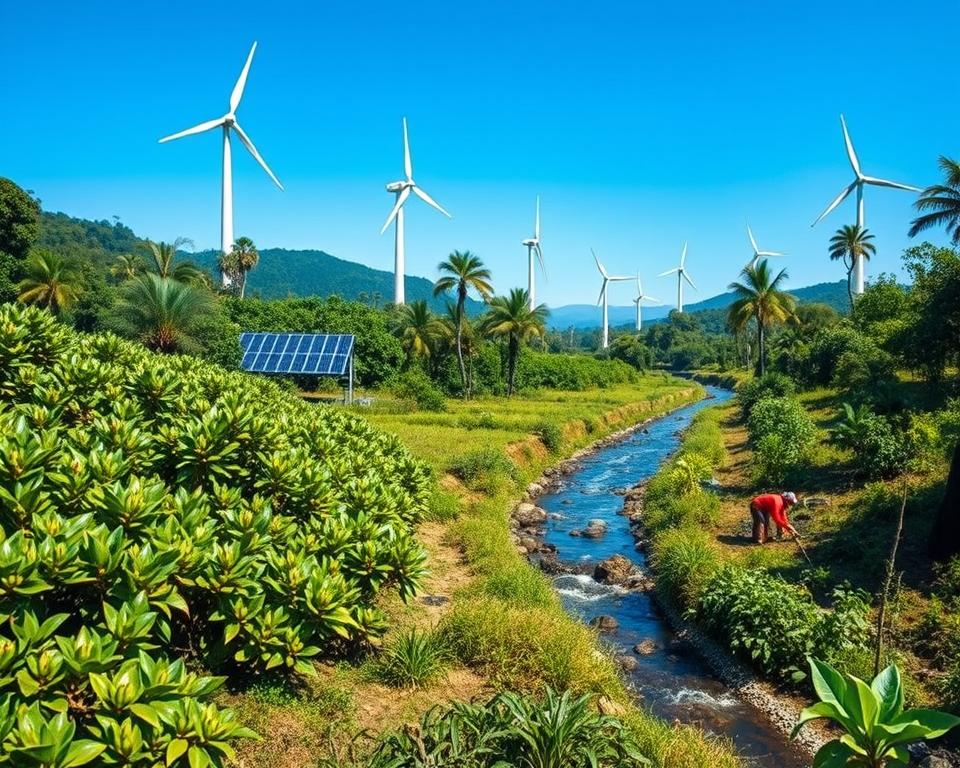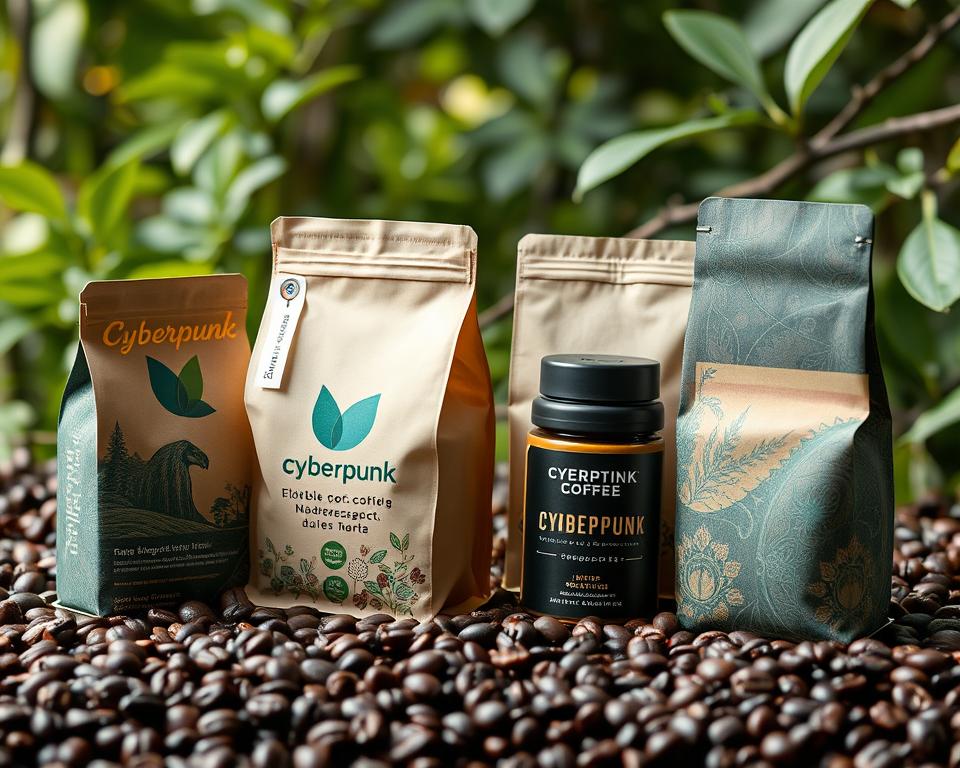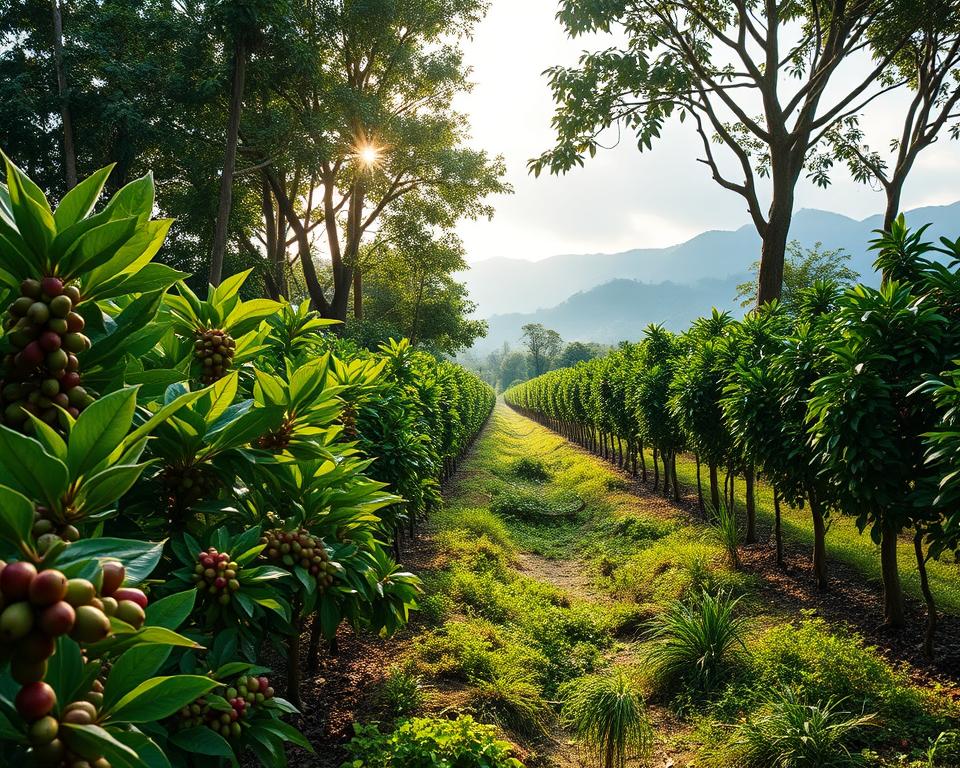More and more people want coffee. By 2050, this demand might triple. We need to know how coffee affects our planet. It’s vital to reduce the carbon footprint of coffee production.
The ‘carbon footprint’ tells us how much greenhouse gas a product creates. For coffee, it covers farming, making, moving, and throwing away the product. This article explains the steps of coffee production. We’ll also talk about making the coffee industry more green.
Understanding Coffee’s Carbon Footprint
Coffee is the second most traded item in the world, right after oil. Knowing how it affects the environment is important. A carbon footprint measures the impact of activities through greenhouse gas emissions. Working on sustainable coffee farming and making the coffee supply chain more efficient is key to a greener future.
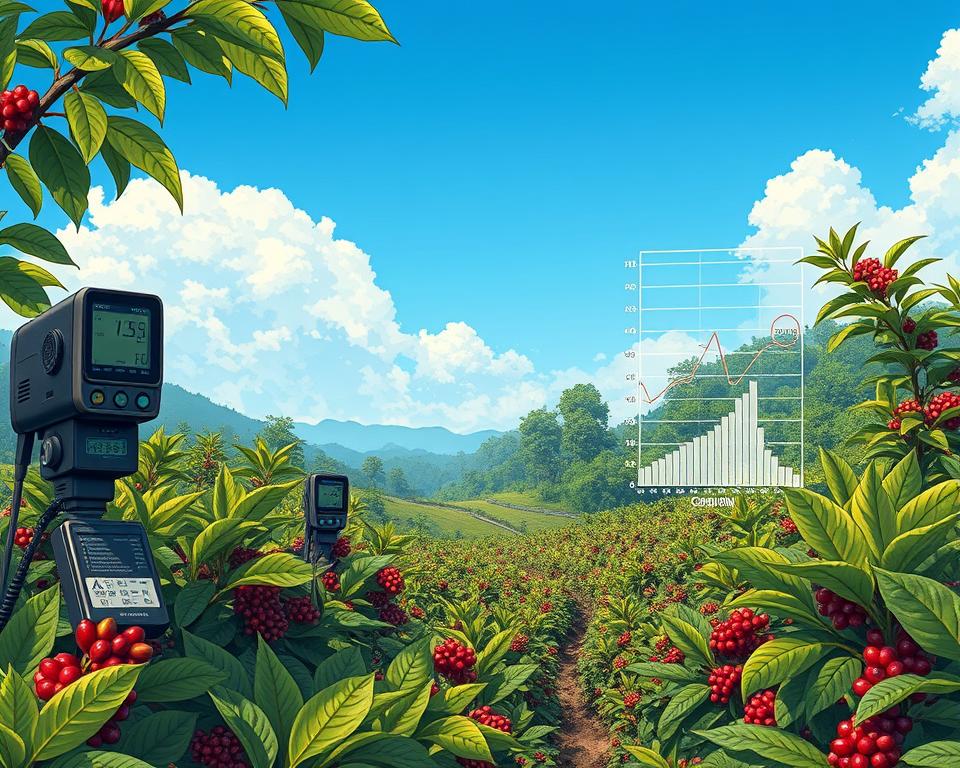
What Is a Carbon Footprint?
A carbon footprint is all the greenhouse gas emissions caused by someone or something. For coffee, this includes emissions from growing, processing, shipping, and even throwing away coffee. As the demand for coffee might triple by 2050, it’s crucial to know the carbon footprint in the coffee industry.
The Lifecycle of Coffee
The journey of coffee’s carbon footprint often starts in places like Vietnam’s Central Highlands and Indonesia’s Southern Sumatra. In the Central Highlands, producing a kilogram of coffee beans emits about 1.83 kg of CO2e. In Southern Sumatra, it’s about 2.38 kg of CO2e per kilo of coffee beans. This includes emissions from using fertilizers, power for irrigation, and dealing with residues. Tools like the Cool Farm Tool help farmers track and reduce their carbon emissions.
Factors Contributing to Coffee’s Carbon Emissions
There are several key factors that add to coffee’s carbon emissions. One is agricultural practices, like using fertilizers and managing residues. Different areas and their farming techniques also affect emissions, as does the type of coffee, like Robusta or Arabica. Transportation and processing steps are important, too. For example, shipping coffee internationally makes up 15% of its greenhouse gas emissions. Finally, the way consumers deal with waste, like throwing away 50 billion non-recyclable cups a year in the U.S., also matters.
To cut down coffee’s carbon footprint, adopting sustainable methods like agroforestry is important. This can greatly help in trapping carbon. Everyone in the coffee industry needs to work together to reduce these emissions effectively.
The Environmental Impact of Coffee Cultivation
Knowing the environmental costs of coffee farming is key to making coffee cultivation sustainable. It helps prevent the loss of biodiversity. We will look into the major ways coffee farming affects our planet.
Deforestation and Habitat Loss
Deforestation is a big environmental problem caused by expanding coffee farms. About 5% of the world’s deforestation comes from making room for coffee. This destroys habitats and causes a lot of species to lose their homes. Coffee used to grow in the shade, which was good for ecosystems.
But now, to keep up with demand, many farmers grow coffee in the sun. This change harms many plants and animals.
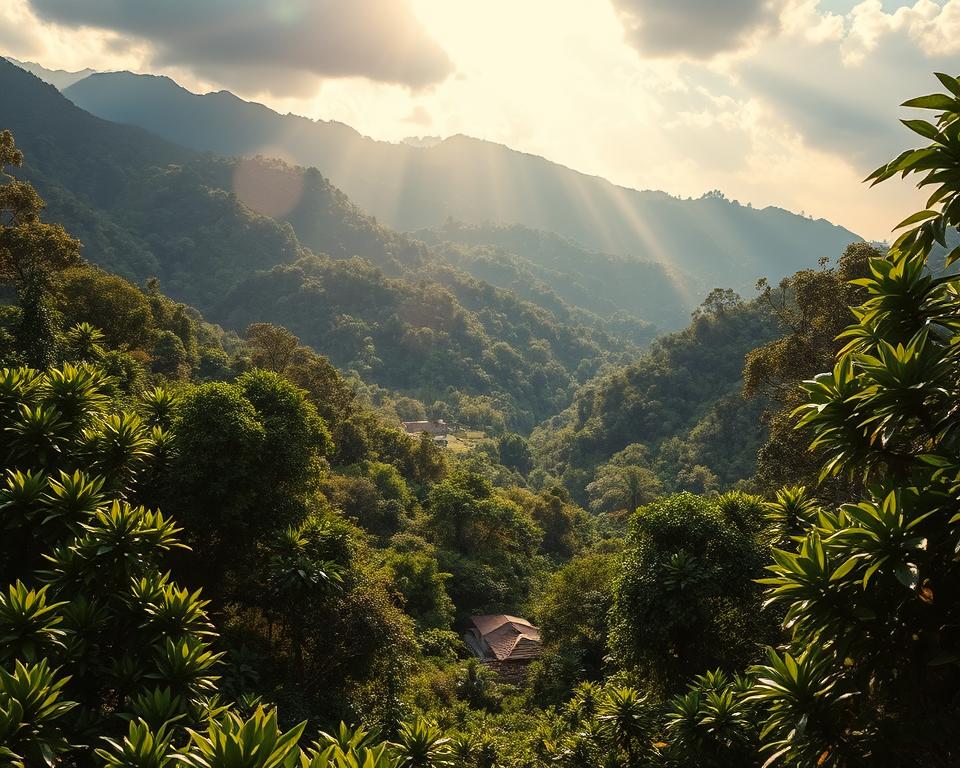
Water Usage and Pollution
How much water coffee farming uses is a big issue. Making one cup of coffee can create up to 50 grams of CO2. This includes the water used and the pollution from making coffee. Coffee-making water often gets dirty with organic stuff and chemicals, which can pollute our water.
Fixing these issues means finding better ways to use water and manage dirty water.
Soil Degradation and Erosion
Keeping soil healthy is vital for coffee to be sustainable long-term. Coffee farming can harm the soil and cause erosion. This is mainly because forests are cleared for coffee plantations. Using chemicals makes the soil worse.
Sustainable practices in coffee farming can protect the soil and keep it fertile. This leads to healthier coffee plants and less disease.
For more on sustainable coffee farming, check out this article.
From Bean to Cup: The Carbon Footprint of Coffee Production
Coffee’s journey from bean to your cup has a big impact on the earth. This includes all parts, like processing, roasting, and how we get it. Every step adds to its carbon footprint.
Coffee Processing and Roasting
The process begins with turning beans into coffee. This uses a lot of energy and creates pollution. Especially roasting, it needs lots of energy and releases CO2. The packaging is another issue, often using materials that are hard to recycle.
Transportation Emissions
After being packaged, coffee travels all over the world. This global coffee transportation impact is huge because it uses a lot of fuel. Coffee is shipped using boats, trains, and trucks. This all adds more pollution to coffee’s carbon footprint.
Even after reaching a country, getting coffee to stores emits more carbon. So, moving coffee around is a big part of its environmental impact.
Consumer Habits and Waste Management
The coffee journey ends with us, the drinkers. Our choices, like brewing methods, are important. For example, French press and drip coffee makers use less energy than pod machines. Also, single-serve pods create a lot of trash.
It’s not just about drinking coffee. In the U.S., 50 billion throwaway coffee cups are used every year. We can help by disposing of coffee grounds properly. Composting them reduces harmful gases from trash dumps.
To really make a difference, try buying locally roasted beans. Choosing fair trade products, plant-based milks, and green brewing options also helps lower coffee’s carbon footprint.
Strategies for Reducing Coffee’s Carbon Footprint
Reducing coffee’s carbon footprint needs efforts from everyone in its supply chain. Consumers want coffee that’s good for the planet, pushing a move to sustainable methods. There are many ways to make coffee production greener.
Collaborative Initiatives
Working together is crucial for changing the coffee scene. The industry’s push for teamwork links farmers, roasters, and shops. Together, they can embrace green business models and cut emissions.
For instance, carbon insetting lets companies balance their emissions by investing in green projects in their own chain.
Adopting Sustainable Agricultural Practices
Regenerative farming is a key method for greener coffee. It includes organic farming, shade-grown crops, and agroforestry. These help the soil, save water, and boost wildlife.
The practices improve bean quality and cut emissions. They also combat climate change, keeping coffee farming alive for the future.
Using Data and Metrics for Improvement
Using data helps make farming smarter and less polluting. Setting carbon targets shows farmers where they can do better. Tracking and analyzing data lets them fine-tune their approach to emit less.
Bellwether Coffee shows how tech, like electric machines, can make a big difference. For more tips on eco-friendly coffee, check out this guide.
Promoting Awareness and Education
Educating people about green coffee is essential. Telling farmers and buyers about sustainable farming can boost the demand for green coffee. It’s important to share knowledge on managing land well and carbon insetting.
By spreading awareness, we help build a sustainable coffee culture. We need all hands on deck to lessen coffee’s environmental impact.
Using these strategies together can greatly reduce coffee’s carbon footprint. Embracing regenerative farming, lowering emissions, and working together are key for a greener coffee industry.
How Can Using Reusable Coffee Filters Help Reduce the Carbon Footprint of Coffee Production?
Using reusable coffee filters contributes significantly to ecofriendly coffee brewing solutions. By eliminating the waste generated from single-use filters, coffee lovers can minimize their environmental impact. This sustainable choice not only reduces landfill waste but also promotes a greener lifestyle, supporting the planet while enjoying a daily cup of coffee.
Conclusion
Tackling the carbon footprint in coffee making needs action from us all. This includes consumers, farmers, and others in the supply chain. By realizing coffee’s effect on the planet, we can choose to support green coffee methods. Choosing shade-grown coffee affects how sustainable the coffee industry is.
For a greener coffee industry, we must use new technologies and smarter farming. Using a plug-in kettle instead of a microwave saves more energy. This cuts down our carbon footprint every day. Choosing organic coffee helps reduce pesticides and protect wildlife, making a better environment. Discover more on how to lower coffee’s carbon footprint here.
Raising awareness about green coffee is key. Supporting eco-friendly coffee and fair work conditions strengthens coffee communities. The move to a sustainable, eco-friendly coffee industry continues. With everyone’s effort to use climate-smart agriculture and green practices, we can lessen the environmental damage. We aim for a future where the coffee industry and environment both flourish.
FAQ
What Is a Carbon Footprint?
A carbon footprint is how we measure the impact of our activities on the planet. It looks at the total greenhouse gases we produce. This includes things like farming, moving around, and throwing things away.
How does the lifecycle of coffee contribute to its carbon footprint?
The whole journey of coffee, from growing to getting rid of it, impacts its carbon footprint. Growing, making, moving, and disposing of coffee all add up. We can make each step greener for a better environment.
What factors contribute to coffee’s carbon emissions?
Coffee’s carbon emissions come from how it’s grown, land changes, energy in making it, and moving it around. Using resources smarter at each step can cut down emissions.
How does coffee cultivation affect the environment?
Growing coffee can harm forests, animal homes, and different kinds of life, especially in Latin America. It also strains water, pollutes from waste, and damages soil.
What is the impact of coffee processing and roasting on emissions?
Making and roasting coffee needs a lot of energy and makes waste. This adds a lot to its carbon footprint. New ways of doing these can lower emissions and help our planet.
How do transportation emissions affect coffee’s carbon footprint?
Moving coffee around the world uses lots of fuel and creates greenhouse gases. Choosing greener ways to transport it can reduce its footprint.
What role do consumer habits and waste management play in coffee’s carbon footprint?
How we make and throw away coffee matters a lot. In the U.S., we toss out 50 billion non-recyclable coffee cups each year. This hurts our planet a lot.
What are some collaborative initiatives to reduce coffee’s carbon footprint?
Working together, using sustainable business ideas, and setting clear goals can make a big difference. These actions are key to making the coffee industry greener.
How can sustainable agricultural practices help reduce coffee’s carbon footprint?
Using land wisely and growing coffee with nature can save resources and lower emissions. These ways help nature and make the land healthier.
How can data and metrics be used to improve coffee production sustainability?
Tools and rules based on data can make farming smarter, use less, and help us see if we are reducing our carbon footprint. This helps us do better for our planet.
Why is promoting awareness and education important for sustainable coffee production?
Teaching about green farming can make more people want to use it. Knowing how it helps can bring more people to join in making coffee in a way that’s good for our planet.


